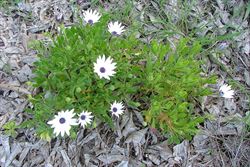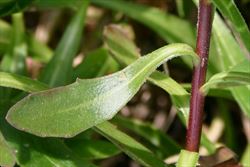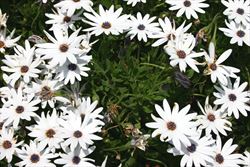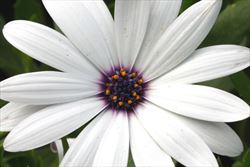Click on images to enlarge

infestation (Photo: Sheldon Navie)

upright, bushy habit (Photo: Sheldon Navie)

habit in flower (Photo: Sheldon Navie)

close-up of stem and upper leaf (Photo: Trevor James)

flower-heads (Photo: Trevor James)

flower-heads (Photo: Sheldon Navie)

close-up of flower-head with purplish centre (Photo: Trevor James)

mature fruit (Photo: Sheldon Navie)

young plant with lower leaves (Photo: Sheldon Navie)
Scientific Name
Dimorphotheca ecklonis DC.
Synonyms
Osteospermum ecklonis (DC.) Norl.
Family
Asteraceae (Queensland, New South Wales, the ACT, Victoria, Tasmania, Western Australia and the Northern Territory)Compositae (South Australia)
Common Names
African daisy, African veldt daisy, blue and white daisybush, blue daisybush, blue-and-white daisy bush, blue-and-white daisybush, Cape daisy, Cape marguerite, dimorphotheca, freeway daisy, osteospermum, sailor boy daisy, star of the veldt, Sunday's river daisy, Van Staden's osteospermum, Van Staden's river daisy, Vanstaden's daisy, Vanstaden's river daisy, veldt daisy, white daisy bush, white daisybush, white veldt daisy
Origin
Native to south-western Africa (i.e. Cape Province in South Africa).
Naturalised Distribution
This species is becoming widely naturalised in eastern Australia (i.e. in south-eastern Queensland and some parts of eastern New South Wales) and in south-western Western Australia.
Also naturalised overseas in south-western USA (i.e. California).
Notes
African daisy (Dimorphotheca ecklonis) is regarded as an emerging environmental weed in New South Wales and Western Australia, and as a potential environmental weed or "sleeper weed" in other parts of southern Australia.

